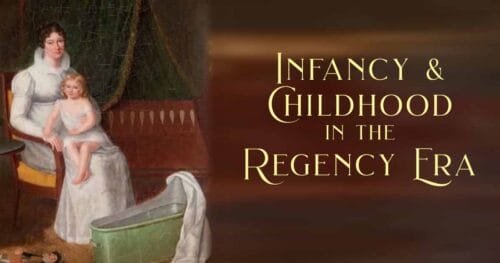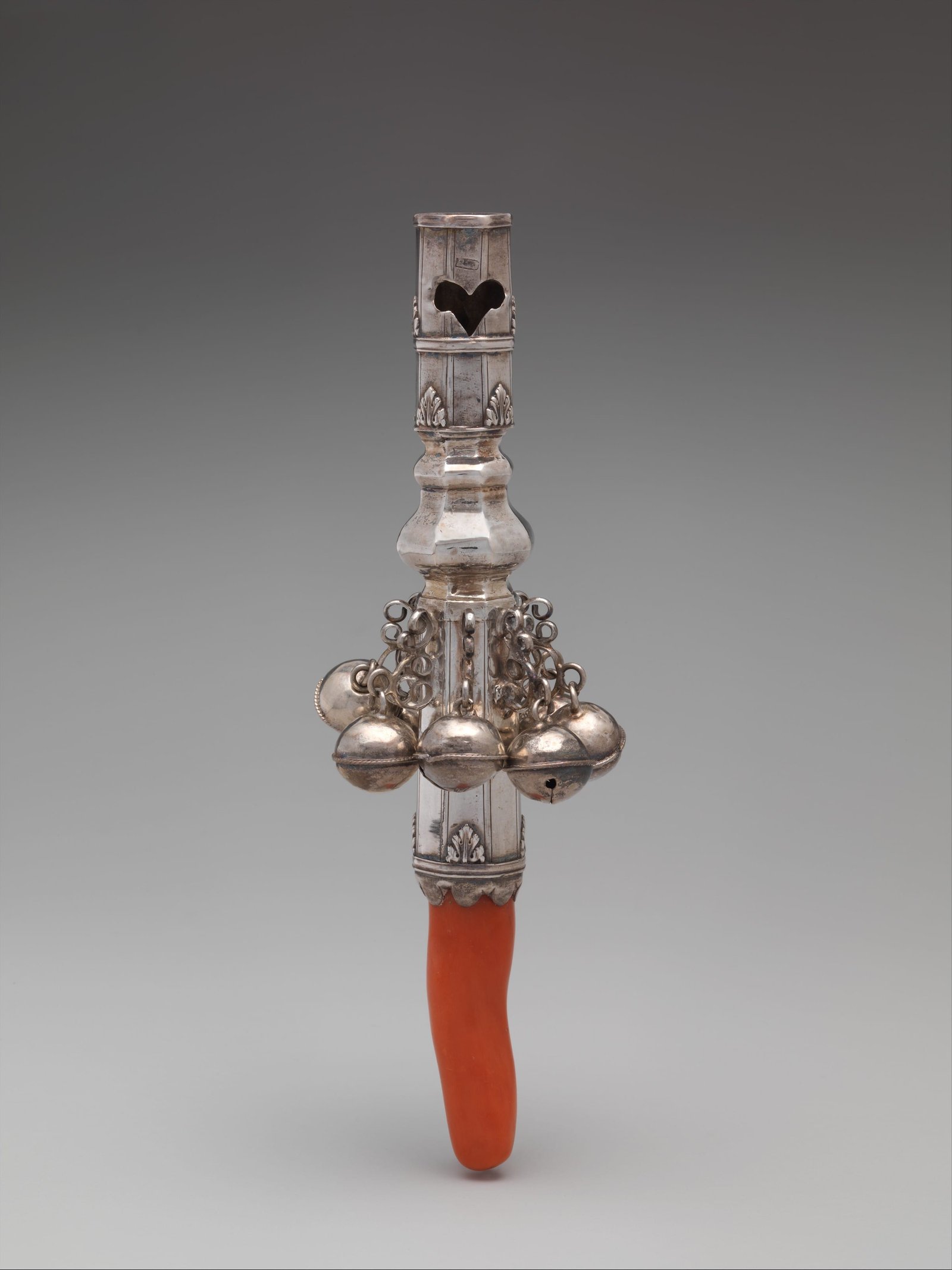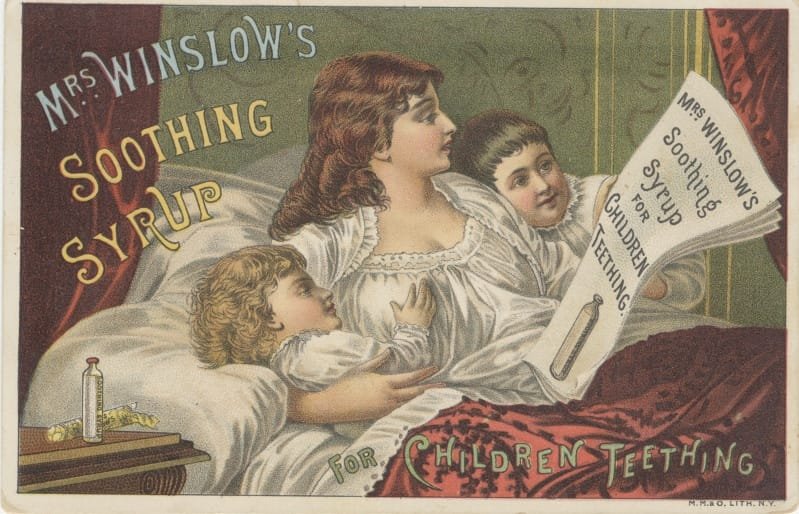Dangerous, even deadly: Teething in Jane Austen’s World


Anyone who has dealt with young children knows the misery teething can bring, not just to the baby, but the entire household. Modern parents expect teething to begin at about five months, ushering in fussiness, sleep disruption and drooling, but nothing more difficult or dangerous than that.
Twenty four hundred years ago, though, Hippocrates warned parents of the fever, diarrhea and convulsions teething could produce. 18th century Scottish physician John Arbuthnot estimated one tenth of children died while teething. (Mims, 2005) Others estimated up to one third of infant mortality was due to teething. (Day, 2013)
What changed?
Dreaded Dentition
!8th century French physician Jean Baumes (1783) wrote “All experience teaches that dentition is to be dreaded.”
Why the dread? In layman’s terms, the irritation of the gums and possibility that teeth might fail to break through could upset a child’s fragile nervous system. Obviously, right? Such disruption could lead to convulsions or even death. Buchan (1838) suggested “These symptoms are in a great measure owing to the great delicacy and exquisite sensibility of the nervous system at this time of life, which is too often increased by an effeminate education. Hence it comes to pass, that children who are delicately brought up, always suffer most in teething, and often fall by convulsive disorders.”
In other words, it was probably mom’s fault. Of course.
Still some children cut teeth without significant issues. This Baumes attributed to healthy parents and good quality care of the child. A woman who “restrained her passions during pregnancy” and “retained a tranquil mind” helped insure her child would have successful teething. But errors of diet and “abuses of regimen” could lead to feebleness of constitution, an imbalance of fluids, and “organic disorders of bodily systems.”
According to period physicians, dentition contributed to two major groups of illnesses: digestive and nervous. Digestive ills included diarrhea (which killed many infants no matter what caused it) constipation, vomiting (also potentially deadly), cough, colic and hiccoughs. Even more dreaded were the nervous complications: restlessness and fitful sleep which could lead to exhaustion, derangement and convulsions. Cases of “dental paralysis”, especially upon the eruption of the canine teeth, were even reported. All of these could lead to death.
A Charm Against Teething Evils
Regency medicine was more medieval than modern, so superstition and ancient beliefs still held powerful influence over treatments. Medicinal amulets to ward off evil were every bit as reliable and quite possibly as effective as the doctors of the era. (And probably a good deal less dangerous … just saying.) Many relied upon the protective power of coral.

Belief in coral was steeped in centuries old traditions. Ancient Greeks and Romans believed coral would ward off a variety of infantile illnesses. Plato wrote of the value of wearing coral amulets and hanging them in cradles and nurseries. Ancient Egyptians believe coral would ease teething pain. By the 16th century, coral beads became a common christening gift among the wealthy classes.
(Total aside here, it is interesting to note that coral beads were a very fashionable accessory for young ladies of the Regency era. It does make one wonder about them as possibly infantilizing young women as well… but back to teething now…)
Coral teething sticks became popular as well. And then as now, whatever is popular tends to become fashion statements and, well just plain overdone.
Artisans designed elaborate teething rattles for their wealthiest of patrons. Usually fashioned out of silver and gold (both considered to have supernatural powers of course) these odd looking accessories would have a whistle on one end and the coral sticks on the other. Bells, silver ones in particular, would be hung around the base of the whistle, their pure tones repulsing evil spirits and drawing in good ones—and distracting the baby as well. A ribbon allowed them to be suspended from the baby’s neck or tied at the waist. (Yet another great idea, right?)
Less ornate teething ‘corals’ were also available, but not nearly the status symbols the elaborate ones were. Still though, they provided the same benefits. Corals provided a tough, but safe substance for babies to bite down on and gave parents the peace of mind they were doing something to protect their baby through a difficult and dangerous time.



Teething Treatments
When teething corals did not provide sufficient relief, physicians and superstitions had numerous treatments to offer. (And if you ask me, I think, in this case I’d go with the superstitions…)
Since babies drool during teething, saliva was though to soften the gums. If it was insufficient to the task, a number of preparations were available to help nature along. Parents were told to rub chicken grease or fresh hog’s lard lightly and frequently over infant’s gums. A somewhat less palatable alternative was to use hare’s brains for the same purpose. Yum.
When a family could not afford coral, ivory, wolves teeth or bone might be given to a child to bite on. If those were not available, a child might be given a dry bread crust, a lump of sugar wrapped in cloth, licorice sticks dipped in honey, carrot sticks or wax candles.
I just heard my dentist friends gnashing their teeth.
Baumes (1783) discouraged the uses of gum rubs as vulgar. Furthermore, he thought giving children hard substances to bite as they would harden and callous the gums, making teething harder rather than easier. I see you rolling your eyes, but wait, it gets better.

http://wellcomeimages.org
Creative Commons Attribution only licence CC BY 4.0
Instead he recommended standard era treatments including enemas, purgatives, emetics, bleeding, blistering, plasters, cauterization and leeching. Buchan (1838) gives us a sound scientific explanation why: “Difficult teething requires nearly the same treatment as an inflammatory disease. If the body be bound, it must be opened either by emollient clysters or gentle purgatives; as manna, magnesia alba, rhubarb, senna, or the like. The food should be light, and in small quantity; the drink plentiful, but weak and diluting, as infusions of balm, or of the lime-tree flowers; to which about a third or fourth part of milk may be added. If the fever be high, bleeding will be necessary; but this in very young children ought always to be sparingly performed….Purging, vomiting, or sweating, agree much better with them, and are generally more beneficial.”
Of course, this makes perfect sense. But wait, there’s more.
Under the most severe of circumstances, era surgeons might go so far as lancing an infant’s gums. Baumes (1783) warned though that a simple incision was not always enough. The gums needed to be lanced down to the teeth and skin flaps excised to fully liberate the teeth. In the most extreme cases, the tooth socket might be broken or tooth extracted.
Would you believe that it was only at the turn of the 20th century that medical science disavowed the use of lancing to treat teething?
A few medicinal preparations were available to soothe babies’ pain and help them sleep. The most basic was to give them a cloth soaked in brandy to chew or suck on. (Then again, after all this stress and worry, mom might be the one more in need of that.)

On a more commercial level, a number of preparations became available, like Mrs. Winslow’s Soothing Syrup. Most of the concoctions were solutions of alcohol and morphine, possibly with various herbal components. A few boasted calomel, a mercury-based compound, as well.
So let’s review, leeches, bleeding, lancing, alcohol, opiates and mercury versus lard and hare’s brains. There’s a reason I suggested superstition was a safer alternative for teething babies.
No wonder teething was such a cause of infant mortality!
References
Baumes, Jean Baptiste Timothée. A treatise on first dentition and the frequently serious disorders which depend upon it. Translated by Thomas Emerson Bond. New York: Raetas & Kelley, 1841. (French version written by Jean Baptiste Timothee Baumes published in 1783)
Buchan, William. 1838. Domestic Medicine: Or, A Treatise on the Prevention and Cure of Diseases by Regimen and Simple Medicines: with Observations on Sea-bathing, and the Use of the Mineral Waters. To which is Annexed, a Dispensatory for the Use of Private Practitioners. J & B Williams, London.
Day, Nicholas. “Your Baby’s Teething? Rub a Minnow on It.” Slate Magazine. April 17, 2013. Accessed March 16, 2017. http://www.slate.com/blogs/how_babies_work/2013/04/17/teething_in_history_folk_remedies_and_quack_science.html.
Hunter, Sonja. “Rethinking “Teething” Deaths.” Rethinking “Teething” Deaths. March 01, 2013. Accessed March 10, 2017. https://kalamazoogenealogy.blogspot.com/2013/03/rethinking-teething-deaths.html .
Kane, Kathryn. “Corals: Protection for Teething Babies.” The Regency Redingote. January 09, 2014. Accessed March 6, 2017. http://regencyredingote.wordpress.com/2014/01/10/corals-protection-for-teething-babies/.
Mims, Robert. “S.L. DOCTOR EXAMINES THE MYSTERY OF PIONEER INFANTS’ `TEETHING’ DEATHS.” DeseretNews.com. December 22, 1991. Accessed March 10, 2017. http://www.deseretnews.com/article/200511/SL-DOCTOR-EXAMINES-THE-MYSTERY-OF-PIONEER-INFANTS-TEETHING–DEATHS.html.
Stempniak, Marty. “TBT: In the 1800s, One Opium-Laced Drug Helped Moms Soothe the Pains of Teething Children.” H&HN. March 31, 2016. Accessed March 16, 2017. http://www.hhnmag.com/articles/7085-tbt-in-the–s-one-opium-laced-drug-helped-moms-soothe-the-pains-of-teething-children .

O.O Poor kids!!
I just cringed when researching this!
We should count our blessing, that we were growing up in modern times. 🙂
No kidding!
Awful.
I was born in 1953. Mom would cut an apple in half, put it cutmside down, and set me on my tummy. I’d have a wonderful time teething on it.
Sounds much better than hare’s brains!
Aren’t convulsions a common sign of mercury and alcohol poisoning? And they never noticed the correlation?
‘sigh’
I suppose it never occurred to them to think about it.
Yikes. Just…yikes!!
Yikes is a very good word for it!
Heavens Maria! Slightly drastic measure! Thank goodness for modern day practices.
I can sort of see how they thought some things might work but hare’s brains????
This was a fascinating article though, and obviously where Lady Catherine got the idea to lance Pemberley’s gums!
No idea where the idea for hare’s brains came from, but it would be interesting to learn, wouldn’t it? It’s funny how just a simple jump to look for period teething remedies totally made the sequence in the story!
How horrible. I understand the point is that those barbaric treatment attempts might have caused much of the symptoms and mortality – but the symptoms were described by Hippocrates too, and I did not think the ancient Greek people would use the described treatment to otherwise healthy kids.
Harebrained ideas, indeed!
Poor mothers of the time. Even if they did feel the treatment just made things worse, it is a terribly difficult decision to resist the medical expert’s opinion if it’s your child at risk.
My experience wih teething kids of my own, my extended family and friends is that there was a great number of incidents where teething coincided with an attack of infection, in many cases respiratory, but I remember a kid who had repetitive otitis (ear inflammation) when teething. I can see how such coincidences could lead to complications in that era.
My eldest would often have an ear infection while teething, but it was a constant problem with him, so it was more likely coincidence than anything else. But, as you said, how would a mother of that era know that? So thankful for today’s medical advances.
Catching up on e-mailed blogs today: your information is just another reason to be so thankful I was born in modern days. We love to read about Regency times but it was not really a romantic time with the lack of hygiene and medical knowledge. Poor babies.
My grandson is teething right now and researching this just gave me the willies!